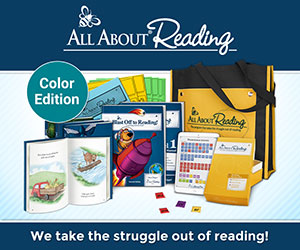This blog post is last part of a three-part series of how we make the different curriculum we use for our home school and how I adapt them to work for us. Here I will share some tips and tricks of how we use All About Reading. Part one of this series talked about how we use Sonlight and part two discussed how we use Math U See.
As I am now taking our second daughter through the All About Reading, I figured I would share a few tips and tricks that I have learned over the years. Our oldest daughter has done all 4 levels plus the pre-reading level. Our youngest has completed level 1 and has also completed the prer-eading level.
Some general ideas that you should know are that AAR is a mastery-based program. This means that you move with the pace of the child and not the pace of the program. You could fly through lessons or a lesson could take you several weeks, or you may need to pause the program at any point in time should your child at any point become overwhelmed. The level of this program has taken us anywhere from 1 to 1 ½ year to complete. It took longer to complete during the earlier levels of this program. Mastery, at least to us, is that the child can re-teach the material back to us or that they have a quick recall of the concept and are not searching for the answer. This means they are not hesitating or sounding out every word still. They have a quick, almost instant recall of the word cards and do not struggle to remember the phonograms.
All about Learning Press also suggest setting a timer and only working on a lesson for 20 minutes a day. This didn’t exactly work well for me. I didn’t like the interruption of a timer, and it made me anxious, and I felt rushed, which did not translate well into teaching my oldest when we first started out. Instead, I found a natural rhythm that worked out to about 10-20 minutes worth of work, depending on the day. Here are some of the tips and tricks I have used for us to make this program successful for us to work within that natural time block.
1. Review Word Cards every day: if you have them. This is the first thing we do to start our lesson time. We review cards even on the days when the lessons are stories. In the upper levels, as word cards became easier, we had cards for two days. Day one was an introduction, and day two was for mastery.
2, Divide up the Fluency Pages or Pre-Reading-Sheets: We divide the page in at least half. Sometimes, depending on how many sections are on the page and if it is double-sided, we can spend 2-4 days on one fluency sheet. Too many words at once can overwhelm a reader. I do ask once we get done with a section if they would like to do more that day. Some days they do, and other days they do not. The days they don’t, you can tell that their brain had just enough work to help improve the skill you are working on.
3. Repeat the Activities in the Lessons: While it may seem monotonous to you, the repetition is fun. So Feed that monster, flip them eggs, Match the Sock etc. Several times as you work through the lesson over multiple days. Reading should be fun and engaging at the early stages. The activities help to foster that.
4. STOP: Take a break and stop the program if you need to. If you are continually adding words to the be reviewed pile and not adding cards into the master section, then just STOP. Breathe and be patient for the process. This does not mean that the program is not working. It means that you are not going at the pace of your child. I pause several times in the first levels. We re-read stories from the reader and make games out of the review cards. Our favorite games are to play tic tac toe and memory. I have also supplemented Bob Books into the program allowing more opportunities to practice reading as well as practicing word cards every day.
5. Read Stories Twice (or More): The first time we read a story it is for decoding practice. The second (third or fourth time) is for fluency practice. The same as with the Activities. It may seem monotonous, but consistency is what you are looking for when you are practicing early reading skills.
That’s it. These five things help us make the most out of using this reading program. By the time we were in the second half of level 3, and then in level 4, we were able to speed up more. I can only attribute this to the time we took in the early levels to lay the wonderful foundation that this program offers.
I will end this post with a disclaimer. I am not being paid by All About Learning Press for this blog post. I have not and don’t foresee myself receiving money for this post. However. As of 11/14/2022, this post now contains affiliate links. I make a small commission from purchases within some of the links within the post.
I spent the earlier years of my oldest daughter’s life researching homeschooling. While I have a background in teaching, I did not have the training to teach someone how to read. I researched many curricula and found All About Reading during that search. I knew this program would work for us because of its hands-on tactile approach to the letters and the fact that it teaches the why behind things. I knew this is what I personally needed to be able to teach my child.



